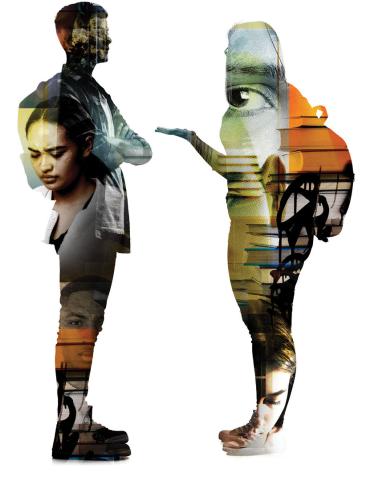Ethnic-racial tensions in U.S. society are not new.* They bubble up in all types of places, from rural communities in California to the multicultural mecca of New York City’s neighborhoods. We can look to historical and current events that not only reflect our society’s tense atmosphere concerning ethnic-racial relations at any given point in history but also continue to ignite and exacerbate such tensions. For instance, the U.S. government has passed immigration policies to exclude individuals from certain countries. This was true in 1882 with the Chinese Exclusion Act and in 2017 with Executive Order 13769, also known as the Muslim ban.
Our society has also forced ethnic minorities to choose between their culture and their survival. We have seen this with the government-imposed boarding schools for American Indian children and in English-only legislation that persists despite well-documented evidence of the benefits of bilingualism. Moreover, we have consistently witnessed the disproportionate use of force and violation of basic human rights as the default in how law enforcement approaches communities of color. These issues persist and make their way into the lives of our young people.
To some, these tensions convey that there is a devaluing of members of groups that do not represent the historically dominant group (i.e., white, European descent, Christian, economically advantaged). This devaluation is like salt in a wound for those who are all too acutely aware of social inequalities that have pervaded U.S. society since its founding. Indeed, there are myriad disparities in the life outcomes of members of marginalized groups compared to members of the dominant group. To others, however, these tensions are thought to be blown out of proportion, exaggerated, or of no relevance to their lives. There is a sense that those who are actively voicing their concerns about the racial tensions are being too sensitive.
In the United States, one does not need to go far to encounter situations in which racial and ethnic dynamics are at work. Youth are bombarded with messages about race and ethnicity in their everyday lives. Such stories, images, situations, and broader conversations often evoke fear, pain, and guilt among even the most socially conscious adults who consider themselves well-versed in the complexities of ethnic-racial relations in U.S. society. It’s challenging to reconcile the disparate perspectives on these ethnic-racial tensions, much less have open dialogue about them, but our social fabric is weakened by not engaging in meaningful dialogue about these issues.
In our book, Below the Surface: Talking with Teens about Race, Ethnicity, and Identity, from which this article is excerpted, we openly discuss many current ethnic-racial disparities and tensions about which conversations are usually stifled. Here we briefly discuss why these conversations are challenging but of the utmost importance.
Why Focus on Youth?
From a child development perspective, children have a strong preference for equality and fairness, and they demonstrate an increasing concern for fairness and others’ welfare with age.1 Scholars such as Melanie Killen, Adam Rutland, and their colleagues have shown the prevalence of children’s moral concerns regarding equality and justice.2 Children’s moral concerns about fairness and justice are in direct opposition to the realities of various manifestations of inequality in society. As youth become increasingly aware of the disconnect between their moral ideals and the unequal opportunities afforded to nonwhite Americans, adults have an important choice to make. We can be silent, teach them to blame the victimized groups for the oppression they experience, or choose to have the difficult conversations that expose the imperfections of our society. The last option is likely the most challenging for adults who themselves have not explored these topics in great depth; however, this approach shortchanges youth. To paraphrase noted scholar bell hooks, we cannot empower young people to critically examine the inequalities they perceive in society without personally facing these issues in ways that may make us feel vulnerable, too.
Young people understand this vulnerability all too well. As they mature during the course of adolescence, youth are thrust into a meaning-making process about society’s racial and ethnic zeitgeist. They must develop a sense of who they are and who they can be in a deeply conflicted society, and the experiences and knowledge gained during childhood serve as the foundation for this process. Making sense of diversity in a developmentally attentive way involves helping adolescents grapple with the question “Who am I, and how do I fit in this diverse world?”
To best foster the development of skills and competencies that will help adolescents make sense of their identities and of the diversity that exists in society in productive ways, adults must engage in the difficult conversations—both among ourselves and with our youth. Indeed, some of the most significant opportunities to engage in these conversations occur during adolescence. During this developmental period, youth gain more freedom to explore the world outside their immediate family and gain the cognitive abilities to think about more complex and abstract social issues, such as racism and societal hierarchies.
Events that highlight ethnic-racial tensions and inequality, such as those that are well publicized in the national news—as well as those situations taking place closer to one’s community that are less well publicized—strike a chord because we may have uncritically accepted the rhetoric that we live in a colorblind society where individuals are judged by their merits and treated in a just and fair manner. In fact, following the 2016 presidential election, many of us, Democrats and Republicans alike, were shocked to learn that white nationalism is not a relic of the past and, quite to the contrary, is a thriving movement that had enough momentum to shape the discourse during the election.
Undoubtedly, parents, educators, and others who work with young people want them to reach their full potential; the problem, however, is that many of us struggle with how to best help our youth understand the complicated issues that arise as a function of ethnicity and race. The activities of a white, award-winning former English language arts teacher in Texas, Emily E. Smith-Buster, provide an excellent example of the potential challenges for educators. In a speech to her colleagues at the time, she explained her evolution from being an excellent teacher who was hesitant to talk about race to one who accepted the challenge of questioning her own views on race and ethnicity; this consequently transformed her pedagogical approach so that it more fruitfully met the needs of her Latino, black, and white students:
Things changed for me the day when, during a classroom discussion, one of my kids bluntly told me I couldn’t understand because I was a white lady. I had to agree with him. I sat there and tried to speak openly about how I could never fully understand and went home and cried, because my children knew about white privilege before I did. The closest I could ever come was empathy.
My curriculum from then on shifted. We still did all of the wonderful things that I had already implemented in the classroom, except now the literature, the documents, the videos, the discussions, the images embodied the issues that my children wanted to explore. We studied the works of Sandra Cisneros, Pam Muñoz Ryan, and Gary Soto, with the intertwined Spanish language and Latino culture—so fluent and deep in the memories of my kids that I saw light in their eyes I had never seen before. We analyzed Langston Hughes’ “Let America Be America Again” from the lens of both historical and current events and realized that the United States is still the land that has never been.
Looking back, I think that my prior hesitation to talk about race stemmed from a lack of social education in the classroom. A lack of diversity in my own life that is by no means the fault of my progressive parents, but rather a broken and still segregated school system. Now that I’m an educator in that system, I’ve decided to stand unflinching when it comes to the real issues facing our children today. I’ve decided to be unafraid to question injustice, unafraid to take risks in the classroom—I am changed. And so has my role as a teacher.
I can’t change the color of my skin or where I come from or what the teacher workforce looks like at this moment, but I can change the way I teach. So I am going to soapbox about something after all. Be the teacher your children of color deserve. In fact, even if you don’t teach children of color, be the teacher America’s children of color deserve, because we, the teachers, are responsible for instilling empathy and understanding in the hearts of all kids. ...
So teach the texts that paint all the beautiful faces of our children and tell the stories of struggle and victory our nation has faced. Speak openly and freely about the challenges that are taking place in our country at this very moment. Talk about the racial and class stereotypes plaguing our streets, our states, our society. You may agree that black and brown lives matter, but how often do you explore what matters to those lives in your classroom?3
As demonstrated by Smith-Buster’s comments, understanding others’ ethnic-racial experiences can be critical for developing an understanding of one’s own ethnic-racial identity. With an informed sense of one’s own self, one can begin to align diverse perspectives of ethnic and racial dynamics.
Fostering the development of ethnic-racial identity in all young people can provide building blocks with which they can begin to reconcile the diverse ways in which race and ethnicity matter in U.S. society. We provide this information with the goal of helping to advance conversations about not only widely publicized incidents in which race is acutely salient to youth (for instance, the police brutality inflicted on black people that is widely articulated on a seemingly daily basis online and in media reports) but also more subtle, everyday instances in which ethnic and racial dynamics bubble to the surface.
Can Youth Have a Strong Ethnic-Racial Identity and Still Value Other Groups?
At this point, you may be thinking, “OK, that’s great. Everyone needs to feel good and proud about their ethnic-racial group membership. But won’t this just lead to more divisions because, by feeling more connected and proud of our own group, don’t we have to downgrade the value of other groups?” You are not alone in this logic. For many, the concept of ethnic-racial identity conveys a sense of pride in a particular group, and only that group. Working from this perspective, it may be difficult to imagine how promoting ethnic-racial identity can help promote positive intergroup relations. This may be why public and academic communities alike continue to wrestle, uneasily, with the presumed tension between a desire to support youths’ ethnic and racial identity, on the one hand, and promoting positive interracial interactions, on the other hand. At first glance, these two goals seem to be at odds with each other, but they need not be.
First, in work conducted by Jean Phinney and her colleagues,4 adolescents from Latino, black, Asian, and white backgrounds who had thought more about their ethnic-racial identities actually reported more positive views about engaging with others who were from different ethnic-racial groups, a skill that has been referred to as “ethnic-racial competence,” or the ability to behave in ways that invite positive relationships with peers from other ethnic groups.5 Second, having a positive sense of one’s ethnic-racial identity promotes social competence with peers, such as the ability to productively navigate social interactions and form friendships.6
In Denise Newman’s work with American Indian youth, those who were more interested in learning about their culture were more likely to have prosocial relationships, and less aggressive interactions, with their peers. Thus, rather than impeding the ability to interact or engage with others, a stronger ethnic-racial identity actually promotes competencies in youth that help them engage in more positive relationships with their peers.
In addition to adolescents’ ethnic-racial identity informing positive social relationships with peers, in our own work, we also find that having more ethnic, racially diverse friendship groups promotes increases in ethnic-racial identity exploration among middle school boys and girls six months later.7 Furthermore, in our focus group discussions with black, white, Latino, and Asian American high school students, they explained that the process of learning about their own ethnic-racial background was facilitated by learning about others’ ethnic-racial backgrounds.8 Thus, when youth engage in dialogue or share experiences with each other regarding either person’s background, this engages peers in their own ethnic-racial identity development process. (For more on fostering ethnic-racial identity development, see "The Identity Project Intervention.")
We also know from the work of Patricia Gurin and her colleagues that young people of diverse backgrounds need to engage in intergroup dialogue to develop an understanding of their identities, not only on a personal level but also within a broader context of power and oppression. Doing so comes with many benefits. In their own words:
IGD [intergroup dialogue] also promotes understanding one’s racial-ethnic, gender, and other social identities as well as understanding those of others. ... Furthermore, these identities are located in systems of power and privilege, which are not viewed as static but rather as dynamic and allowing for change. ... Thus, ... a critical analysis of inequality and commitment to social responsibility and action are tied to identities as central issues in intergroup dialogue.9
In their work, Gurin and colleagues emphasize the need to keep social identity at the forefront and intentionally use teaching methods that encourage students from different backgrounds to learn about one another both as individuals and as members of social groups.
In sum, theory, research, and practice suggest that having a secure sense of one’s ethnic-racial identity can, under the right conditions, actually help to promote positive intergroup experiences through increased understanding of ethnic-racial injustices and the emergence of ethnic-racial empathy. Furthermore, the extent to which young people have engaged in examining their ethnic-racial identity is, for many, intertwined with their awareness of prejudice, because in the process of learning about themselves, they learn about the status of their group compared to others. Drawing from everything we have learned from our work and that of many others, we conclude that not only can youth have a strong ethnic-racial identity and still view other groups positively, but having a strong ethnic-racial identity actually makes it possible for youth to have a less superficial or more genuine understanding, and therefore value, for other groups.
Indeed, the title for our book was inspired by the idea posed by the famous social psychologist Gordon Allport in his seminal work, The Nature of Prejudice. Briefly, he commented that for intergroup contact to reduce prejudice, it must be based on experiences that help us get beyond the superficial and toward those that allow us to form meaningful common bonds. We believe that providing opportunities for youth to figure out their ethnic-racial identities together is a kind of meaningful connection that is essential for positive intergroup relations.
Deborah Rivas-Drake is a professor of psychology and education at the University of Michigan. Adriana J. Umaña-Taylor is a professor of education in the Harvard Graduate School of Education. This article is excerpted with permission from their book, Below the Surface: Talking with Teens about Race, Ethnicity, and Identity (Princeton University Press, 2019). All rights reserved.
*Throughout this article, we use the term “ethnic-racial” to acknowledge individuals’ experiences with ethnicity and race, as these are often difficult to disentangle. (back to the article)
Endnotes
1. See, for example, M. Killen, L. Elenbaas, and A. Rutland, “Balancing the Fair Treatment of Others while Preserving Group Identity and Autonomy,” Human Development 58 (2015): 253–272; and M. Killen et al., “Development of Intra- and Intergroup Judgments in the Context of Moral and Social-Conventional Norms,” Child Development 84 (2013): 1063–1080.
2. Killen, Elenbaas, and Rutland, “Balancing the Fair Treatment.”
3. V. Strauss, “Teacher: A Student Told Me I ‘Couldn’t Understand because I Was a White Lady.’ Here’s What I Did Then,” Washington Post, November 24, 2015.
4. J. S. Phinney, B. Jacoby, and C. Silva, “Positive Intergroup Attitudes: The Role of Ethnic Identity,” International Journal of Behavioral Development 31 (2007): 478–490.
5. P. Gurin, B. A. Nagda, and X. Zúñiga, Dialogue across Difference: Practice, Theory, and Research on Intergroup Dialogue (New York: Russell Sage Foundation, 2013).
6. D. Rivas-Drake et al., “Ethnic and Racial Identity in Adolescence: Implications for Psychosocial, Academic, and Health Outcomes,” Child Development 85 (2014): 40–57.
7. D. Rivas-Drake et al., “Ethnic-Racial Identity and Friendships in Early Adolescence,” Child Development 88, no. 3 (2017): 710–724.
8. A. J. Umaña-Taylor, “Youths’ Perceptions of Factors That Facilitate and Hinder Ethnic-Racial Identity Development,” unpublished manuscript, 2017.
9. Gurin, Nagda, and Zúñiga, Dialogue across Difference.



